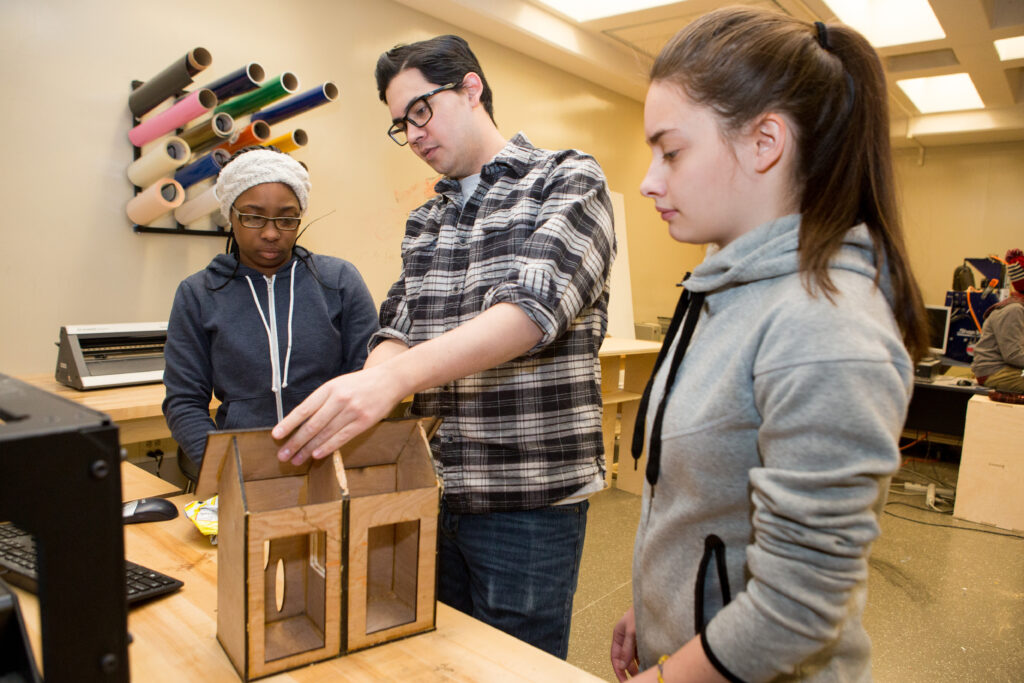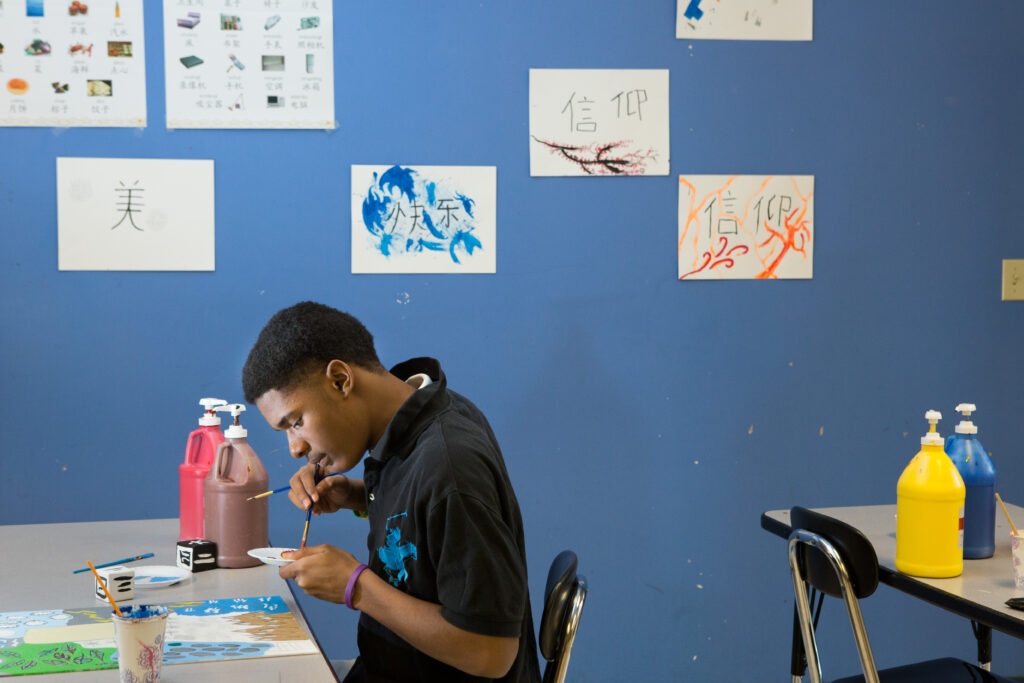
A teacher shows 12th grade students how to construct a small animal house.
Credit: Allison Shelley for American Education
Ina Gutierrez lives for the opera. She has a master’s degree in classical voice as well as a decade of singing and performance under her belt.
She tapped into that lifelong passion to teach music and choir to fourth and fifth graders for two years in Kern County using emergency credentials, and she loved every minute of it but had to stop teaching once that credential ran out.
She now often works as an adjunct professor at CSU Bakersfield, where she teaches “Music in the Classroom,” a class that shows teachers how to share music with children. Gutierrez feels frustrated that she is qualified to show teachers how to teach but can’t teach actual students. She attempted to get a Career Technical Education credential for music but was told she couldn’t use it for elementary school teaching. That broke her heart.
“I would love to be teaching children music,” said Gutierrez, a 38-year-old mother of two who lives in Bakersfield. “Art is so important for children to experience, especially music. It is unique because it simultaneously builds independence and community. In a world where children are playing less outside and addicted to screens, having music in schools shouldn’t be a luxury. It’s vital in building a more compassionate, caring and happy society.”
While many arts education advocates are championing the use of the CTE credential as the state struggles to attract new staff to teach the arts in the wake of Proposition 28, the state’s historic arts mandate, there’s a big hitch for those who want to teach elementary students. It was originally designed for use at the secondary level because it is employment-oriented.
Basically, unless the class has a clear career-based element, like a fifth grade broadcasting class, candidates like Gutierrez might get rejected. Many districts will only greenlight CTE holders to teach middle school, junior high and high school. That’s why some arts education advocates are pushing for reform.
“The CTC language, unfortunately, is from the Eisenhower era when boys took shop, girls took home economics and nobody thought about ‘jobs’ or ‘careers’ until spring of their senior year in high school,” says Austin Beutner, the former superintendent of Los Angeles Unified School District, who authored Proposition 28. “In today’s world, all of this is career-related, and it starts in elementary school.”
Given the state’s teacher shortage and the heightened need for art educators in light of Proposition 28, some are losing patience with the bureaucratic hoops aspiring arts teachers must jump through.
“It is frustrating to see good, qualified individuals being rejected from teaching due to complex bureaucracy,” said Gutierrez’s husband, Greg, who comes from a long line of teachers. “In order for California to fix the teacher shortage, this problem needs to be addressed. We need a process that is easy for potential teachers to work through.”
Bob Woods-LaDue, Gutierrez’s brother-in-law, has hit the same obstacle. He was told he had to get his music class reclassified as a technical class to be eligible to use the CTE credential.
“I can’t help but wonder how many teachers are in an uphill battle that don’t know how to advocate for themselves in the credentialing process, and getting different answers from different people,” Greg said. “It doesn’t seem like an encouraging environment based on his experience thus far and my wife’s similar experience.”
Beutner, for one, is pushing to have the system streamlined so that there are fewer roadblocks for teachers who are dedicated to bringing the arts into elementary classrooms as well as secondary ones.
“Change is hard, but it has to happen,” he said. “California schools will need to hire about 15,000 additional arts teachers to fully implement Prop. 28. Half of the teachers will be needed in elementary schools. There are nowhere near enough traditionally credentialed arts teachers to fill that need.”
Some experts warn that teaching elementary requires a different skill set than secondary. That’s one drawback in widening CTE credential usage, they say.
“I am not sure about broadening it,” said Eric Engdahl, professor emeritus at CSU East Bay and past president of the California Council on Teacher Education. “While it could be a stopgap to fill the arts teaching shortage, are the people teaching it with substantial industry experience appropriate to be teaching at an elementary level given the developmental differences in learning?”
Some working artists may need to bone up on educational best practices before entering the classroom, and Buetner suggests professional development be provided.
“A concern some may have is whether a CTE teacher, even with their content mastery, is ready to be in a classroom with third graders,” Beutner said. “A sensible approach would be to build in some guardrails, maybe a CTE teacher in elementary needs to work alongside a grade level teacher for a semester while participating in a certain set of CTE professional development courses.”
For many, teaching the arts is a dream gig, a way to enrich lives as well as stimulate higher levels of critical thinking in a generation hard hit by pandemic-related learning loss.
“Music is an amazing way to bring that joy to students, invite creativity to the classroom and build connections between students as well as teacher to student,” said Gutierrez. “It is in an environment like this that students can and will learn better. I love music for music’s sake, but music is a great tool to incorporate in teaching language arts, math, science and history.”
While the CTE program has long been associated with trades and vocations such as auto repair, plumbing, and culinary arts, it can also be a viable pathway to becoming an arts educator. Other routes include being a traditionally credentialed arts teacher or a classified staff member, although that role commands lower pay.
One of the key CTE pathways lets artists with considerable experience in their field, from dance and digital arts to jazz, use that expertise in the classroom. They must have three years of work experience directly related to each industry sector named on the credential and meet other administrative requirements.
“The CTE credential allows people who have 1,000 hours of experience in the field to come into teaching, bring all that experience, that wisdom that they’ve got,” said Linda Darling-Hammond, president of the California State Board of Education, during a recent arts ed conference at UCLA. “We hope many, many artists will come in and secure the credential.”
One big upside to the CTE credential is that, unlike teaching artists who need a credentialed teacher to remain in the classroom while they teach, CTE teachers can fly solo. That frees the classroom teacher up, creating time to work one-on-one with students, email parents back and meet with colleagues.
“When CTE teachers are teaching a course, then the regular classroom teacher can be doing other things,” said Darling-Hammond. “Our staff are stretched very thin. So we want to use this as a win-win for students and for staff in all of our schools.”
The greater accessibility of the CTE route, its fewer barriers to entry, may also invite a more diverse range of teachers than more traditional pathways, experts say.
“Let’s roll up our sleeves and bring the CTE standards into the 21st century,” said Beutner. “The alternative is millions of students in elementary schools across California will not have the chance to participate in arts and music.”


